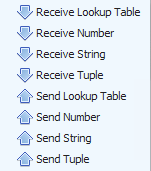External Communication
Dinamica EGO can communicate with external applications by exposing a communication session. By default, an opened session will be created and its name is displayed on the status bar:
To send and receive data, the functors under the 'External Communication' folder in the Library can be used.
Pre Requisites
The following packages are necessary for sending and receiving data using R. To install the packages, do:
install.packages(c("Rcpp", "RcppProgress", "rbenchmark", "inline"))
Command Line
Download Dinamica Package for R and install it:
install.packages("PATH_TO_DOWNLOADED_FILE", repos=NULL, type="source")
where PATH_TO_DOWNLOADED_FILE should match the downloaded file path, e.g. “/home/csr/Downloads/dinamica_1.0.4.tar.gz” on Linux or “c:/Users/CSR/Downloads/dinamica_1.0.4.tar.gz” on Windows.
Using the example path “/home/csr/Downloads/dinamica_1.0.4.tar.gz”:
install.packages("/home/csr/Downloads/dinamica_1.0.4.tar.gz", repos=NULL, type="source")
R Studio
Documentation
The Dinamica R package contains all the documentation available on this page, including examples and R Studio references.
Session
To connect to an existing session:
Dinamica::openSession("DinamicaEGO") # "DinamicaEGO" is the session name.
Send and Receive Data
Real value
To send a Real value (e.g. 3.141592, the PI constant):
Dinamica::sendNumber(3.141592);
To receive a Real value:
myNumber <- Dinamica::receiveNumber();
In the above example, the received Real value will be stored in the myNumber variable.
List / Vector of Real values
To send a list of Real values (e.g. 1, 2, 3, 4, 5):
myList <- c(1, 5); Dinamica::sendNumberVector(myList);
In the above example, the user created myList will be sent.
To receive a list of Real values:
receivedList <- Dinamica::receiveNumberVector();
In the above example, the variable receivedList will store the contents of the received List of Real values.
Lookup Table
Consider the following LookupTable stored on the variable myLUT:
myLUT <- list( Keys = c(1:5), Values = c(1:5) * 2 )
| Keys | Values |
|---|---|
| 1 | 2 |
| 2 | 4 |
| 3 | 6 |
| 4 | 8 |
| 5 | 10 |
To send the myLUT LookupTable:
Dinamica::sendLookupTable(myLUT$Keys, myLUT$Values);
To receive a lookup table:
receivedLUT <- Dinamica::receiveLookupTable();
In the above example, the variable receivedLUT will store the contents of the received LookupTable.
The columns 'Keys' (receivedLUT$Keys) and 'Values' (receivedLUT$Values) will contain the transferred Data.
Table
When transferring Tables, extra caution must be taken (refer to this page for auxiliar tools.)
- Factor columns must be converted to Character Vectors
- Key columns can contain the '*' character on their names (to indicate they represent unique values).
- From R to Dinamica, the Table variable must have the DataFrame type (or compatible).
Consider the following Table:
| Product | Price | Stock Quantity |
|---|---|---|
| Rice | 2.50 | 1e6 |
| Pasta | 1.50 | 500 |
| Corn | 0.50 | 1000 |
myTable <- data.frame(Product = c("Rice", "Pasta", "Corn"), Price = c(2.5, 1.5, 0.5), Quantity = c(1e6, 500, 1000), stringsAsFactors = FALSE)
To send the myTable Table:
Dinamica::sendTable(myTable);
Suppose you want to send the following Table instead:
| State | City | Population |
|---|---|---|
| Massachusetts | Boston | 667137 |
| Massachusetts | Chelsea | 39398 |
myTable <- data.frame(State = c("Massachusetts", "Massachusetts"), City = c("Boston", "Chelsea"), Population = c(667137, 39398), stringsAsFactors = FALSE)
To send the new version of myTable:
Dinamica::sendTable(myTable, 2);
To receive a table:
receivedTable <- Dinamica::receiveTable();
In the above example, the variable receivedTable will store the contents of the received Table.
String
To send a string (e.g. “testing!”):
Dinamica::sendString("testing!");
To receive a string:
receivedString <- Dinamica::receiveString();
In the above example, the variable receivedString will contain the received String value.

